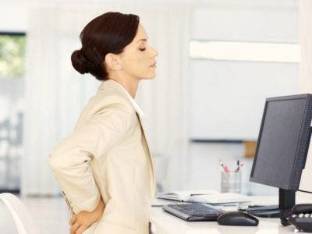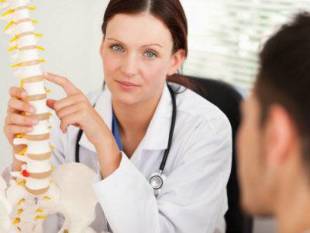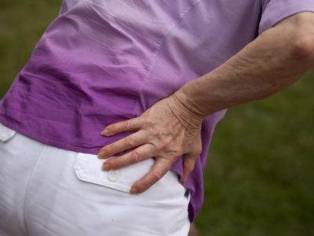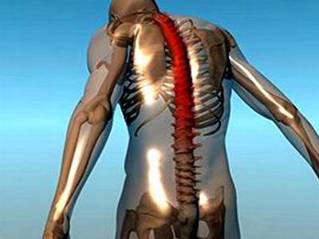If a person has had back pain in the lumbar region, the reasons can be different, up to the pathology renal. Most often this symptom is due to disease of the lumbosacral spine. The lumbar is moving, that most common cause of injury in this region.
Why develop the pain syndrome?

The back pain is only a symptom. Acute pain related to disruption of the lumbar vertebrae and discs, called lumbago. Why back pain in the lower part, everyone should know. There are the following causes of this symptom:
- osteochondrosis of the lumbosacral spine;
- a hernia between vertebrae;
- Bechterew's disease;
- the displacement of the vertebrae;
- congenital malformations (presence of more vertebra lumbar, spina handles);
- congenital disorder of the form of the vertebrae;
- benign, malignant and vascular tumors;
- rheumatism;
- inflammation of muscles (myositis);
- inflammation of the sciatic nerve;
- fracture of the spine;
- spondylolisthesis;
- osteomyelitis;
- cystic fibrosis;
- osteoporosis;
- output disk;
- the narrowing of the spinal canal;
- arthritis;
- renal disease (hydronephrosis, pyelonephritis, tumors).
The spine in the lower part of the back can be bad due to simple muscle spasm. It is possible, with a strong turn or performing sports exercises. Back pain in the lumbar region is most common in people who lead a sedentary lifestyle and lift weights. People involved in the sport, this disease is much more rare.
Lumbosacral osteochondrosis
If you are constantly low back pain, from the back, it can be a manifestation of osteochondrosis of the lumbosacral spine. It is a disease that primarily affects the discs between the vertebrae. They become, in the end, that leads to the friction between them and the decrease of the mobility of the unit. There are the following predisposing factors in the development of this disease:
- stay for hours in an uncomfortable position;
- long of torso;
- insufficient warm-up in the exercise;
- weakness of the muscles and ligaments of the back;
- bring backpacks with 1 strap;
- the presence of flat feet;
- heavy physical work;
- the majority of the static load;
- the bad organization of the work place.
Back pain is the main symptom of degenerative disc disease. If 1 degree of the disease of the pain syndrome is absent. With the development of a disc protrusion develops lumbago. This is one of suddenly, appears the pain in the lower back. Some people feel as a shock. Appears when a strong change of posture or movement.
If the back pain in the lumbar region, the cause may be the lbp. It is a chronic pain in osteochondrosis. Its appearance does not depend on motor activity. The pain is the pain. These people have difficulty to bend the body. In the situation of a person lying on the back syndrome pain disappears or decreases.
Osteochondrosis of 3 degrees developed syndrome root. It seems lumborum ischialgia. It is the pain that gives to the lower limbs down to the toes. It is often combined with the violation of the sensitivity. Discomfort in the lumbar region caused by the compression of nerves, blood vessels and muscle spasm.
The symptoms of hernia

If you're concerned about low back pain, the causes may be herniated. This is a common feature of the disease. The core of the disk of the vertebra. Often against this backdrop, there is a rupture of the ring fibrous. The incidence rate of 150 cases per 100 thousand people. There are the following possible reasons for the formation of a hernia:
- injuries (blue), cache);
- osteochondrosis of the lumbosacral;
- excess weight;
- the curvature of the spine;
- the big returns.
In a situation of risk include drivers and office workers who work at the computer. Pain in the hernia has the following characteristics:
- is a local;
- often radiates to the thighs, the buttocks and the lower part of the leg;
- combined with other symptoms (numbness, tingling);
- increases during the year.
The severity of pain is determined by the size of the hernia. If it is large, which can lead to sciatica. Manifest sciatica. Is severe pain in the form of lumbagoes.
The majority of patients with hernia developing pain in the type of lumbago. Additional symptoms of a hernia include low power, limited mobility of the lower back, weakness in the legs. Sometimes broken urination.
The symptoms in ankylosing spondylitis
When back pain in the sacral region and lower back during long periods of time, it is possible to suspect ankylosing spondylitis.
It is a chronic, systemic disease that most often affects the joints of the spine. The exact causes of this disease is not established. There are the following possible etiological factors:
- swelling of the genitourinary system;
- hypothermia;
- bone injury;
- the genetic predisposition;
- infection.
Ankylosing spondylitis occurs mostly in young people 15 to 40 years. This pathology manifests itself not articulate, and articulate the symptoms. The back pain and stiffness of the spine is considered to be the first symptom. The pain is felt in the lumbosacral region. In the early stages it is expressed badly. Its appearance is due to the inflammation.
The pain is bilateral. Many say that the pain is more pronounced on one side. Has a duration of more than 3 months, and does not happen. The disease develops very slowly. Pain bother these people, mainly in the morning. Perhaps its appearance after a prolonged static load.
Half-day decreases. Pain syndrome increases at rest and disappears during the operation. The stage in the midst of the pain occurs at night and during the work. In the later stages of development of the sciatica. Pain in ankylosing spondylitis combined with the deterioration of the General health of a person, chest tightness, difficulty breathing, drooping of the head, pain in the muscles and chest. Often affects the eyes.
Kidney disease

If the back pain in the lower back, the cause may be disease of the kidneys (hydronephrosis or pyelonephritis). The kidneys are retroperitoneal. When the inflammation (pyelonephritis) lower back pain is the most common complaint of patients. This is the disease often diagnosed in children. Pyelonephritis often develops on the background of kidney stones.
The disease has an infectious nature. More clearly than in acute pyelonephritis. It is characterized by pain in the lower back, nausea, fever, chills, weakness, pain, frequent urination. Often edema. The pain is often unilateral, dull and constant. Irradiation is possible in the region of the hypochondrium, abdomen and the navel.
If there is pain in the lower back, the reasons can be in hydronephrosis. This is a disease in which the expansion of the renal calyx and pelvis. Often, this pathology develops in young children. The basis for the development of hydronephrosis is a violation of the exit of the urine, malfunction of valves and obstruction of the urinary tract.
Hydronephrosis appears sharp pain in the back. She is irradiating. That occurs on the side slightly above the hip bones. The pain is paroxysmal, reminiscent of renal colic. Syndrome of pain combined with nausea, vomiting, appearance of blood in the urine.
Manifestations of sciatica
If strongly hurts the back in the lumbar region, the cause may be inflammation of the sciatic nerve. This condition is called sciatica. The risk group includes older persons. Sciatica (sciatica) often develops on the background of a herniated disc, infectious diseases (flu, malaria, tuberculosis), and osteoarthritis of the poisoning. Sciatica is often observed in pregnant women.
Pain when sciatica has the following characteristics:
- sharp (dagger);
- penetrating;
- intense;
- burning or shooting;
- originally appears at the bottom of the back and then goes down (top-down in nature);
- it extends to the buttocks, thighs and the lower part of the leg;
- worried constantly in the form of attacks;
- has a different effect;
- often unilateral.
The pain is accompanied by tingling, numbness and motor disorders. Other symptoms of sciatica refers to the muscle atrophy, disorders of sweating, dryness and thinning of the skin.
The plan of examination of patients
Not everyone knows what to do if the back pain in the lumbar region. You should go to the doctor and get tested. You need the following investigations:
- computed tomography;
- x-rays of the lumbosacral spine;
- Ultrasound of the kidneys;
- magnetic resonance imaging;
- electroneuromyography;
- vascular Doppler;
- General and biochemical blood analysis;
- urine;
- cystourethrography.
Always perform the inspection and palpation of the lumbar region and the spine. Need to consult a neurologist or vertebrologist. During the exam, the doctor evaluates the mobility of the spine, reflexes, muscle strength, range of motion in the extremities. Almost always the cause of back pain are diseases of the spine. They are easy to identify by the image.
Therapeutic measures

If the back pain, the treatment should be directed at the underlying cause of pain. The following treatment methods:
- systemic drug therapy;
- the use of local anesthesia in the form of gels and ointments;
- physiotherapy;
- the chiropractic;
- acupuncture;
- lock;
- surgical treatment;
- LFK.
These patients must be engaged in gymnastics and to follow a high protein diet. All the work should have a high amplitude. If the back pain is a symptom of pyelonephritis, it is necessary to comply with bed rest, analgesics and antibiotics. In chronic inflammation, in addition, named diuretics. Antibiotics preference for fluoroquinolones and penicillins.
In addition to appointed immunomodulators and vitamins. In the case of hydronephrosis may require surgical treatment. When the pain in the back of the sciatica apply analgesics (Analgin), tool combination, Nsaids. In severe cases, novocaine blockade. In the scheme of treatment include massage, exercises, acupuncture.
To eliminate the pain can be a distraction from the therapy. Apply the ointment with bee or poison of snake. When the hernia is shown to Nsaids, spinal traction, massage and therapeutic exercise. In severe cases, surgery is necessary. When the pain in the back of the sciatica treatment consists of immobilization of the spine, the use of painkillers and an intramuscular administration of anesthesia. In addition, designated vitamins of the B group (Combilipen).
Effective and physical therapy. In the detection of osteoarthritis are shown physiotherapy, massage, pain, physical therapy. It is also named chondroprotectors. These patients need to move around more and to spend less time standing or sitting. In the scheme of treatment include manual therapy and locking. Therefore, the appearance of pain in the lower part of the back is the reason to go to the hospital.

























